
Publisher:
Bonnie King
CONTACT:
Newsroom@Salem-news.com
Advertising:
Adsales@Salem-news.com

~Truth~
~Justice~
~Peace~
TJP
Jan-09-2013 12:31

 TweetFollow @OregonNews
TweetFollow @OregonNews
Daughters of India Violated and Abused
Graham Peebles for Salem-News.comA woman's lot...
 Hospital staff carry the body of the Indian gang-rape victim to the police morgue vehicle at the Mount Elizabeth Hospital. The 23-year-old woman died in Singapore after suffering severe organ failure. Photo: AFP Courtesy: South China Morning Post |
(LONDON) - In the ancient land of India, where female deities deeply revered, Kali and Lakshmi, Sarasvati and Parvati, are held high upon the alter of Hinduism, where each day thousands of Hindu’s ritually bathe in the Holy waters of the Ganges, cleansed within and without by the Goddess Ganga, women and girls; in the forests, cities, villages and towns, on buses and trains, in the street, the office, at school and in the home are being violated, abused, raped and trafficked into prostitution and domestic slavery. Such is life for many, far too many women in the hollow titled ‘largest democracy in the world’; ‘New India’ that sits at the head table rubbing nuclear shoulders beyond treaties of control, whilst denigrating and abusing women throughout the land.
Even the womb offers no sanctuary to the daughter of Kali, with 12 million female fetuses being aborted in the last 30 years. The list of abuse suffered is familiar and appalling; trafficking, prostitution, ‘arranged’ meaning coerced and child marriages – illegal under federal and international law, but widespread, with almost half of girls forced to marry by 18 and 20% by 15 years old; young girls sold as chattels, brides burned alive in dowry disputes, teenagers exploited as domestic workers, which equates to little more than modern day slavery. Completing the catalogue is widespread domestic violence, molestation in public (of Indians and visitors) verbal intimidation and rape, which the National Crime Records Bureau (NCRB)1 says is “the fastest growing crime in India”, and takes place every day, in all manner of situations to all sections of society, young or old. Those sitting comfortably in authourity dismiss sexual assault and rape incidents, 90% of which are perpetrated by someone known to the woman and cite the victim’s dress and demeanour as provocation for the assault.
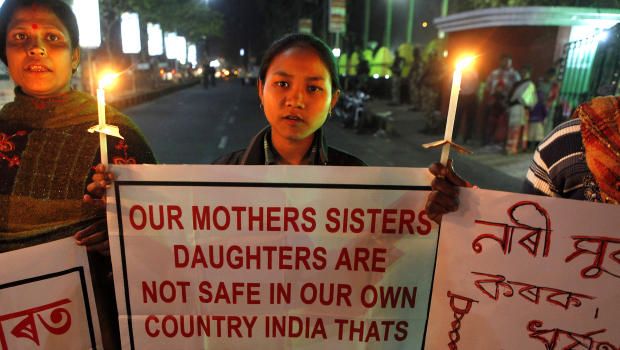
Those immersed in poverty are at greatest risk, the Adivasi (native or indigenous people), all too often branded Maoists or terrorists – same thing to a state at war with its own people, receiving less protection, no respect and the greatest abuse. Rape, according to writer and activist Arundhati Roy,2 is the weapon of choice for security services and forestry personnel deployed against the Adivasi women throughout the forests of central India, Orissa and elsewhere. Women, living with no health care or access to education, whose roots grow deep into the foundations of the nation are, after all ‘only Adivasi’, they are not members of the new middle class club, are not of the time, the ‘New India’, that disregards traditions and values of the old and sacred in favor of the ubiquitous artifacts of wealth. Nike and Channel, Aston Martin and Burberry, Armani and the like, the materialistic tribes of capitalism ruling supreme, the bollywooded face of ‘New India’, trampling mercilessly upon the old, raping the land of resources, the women who nurture and protect it, of their dignity.
Large democratic statistics
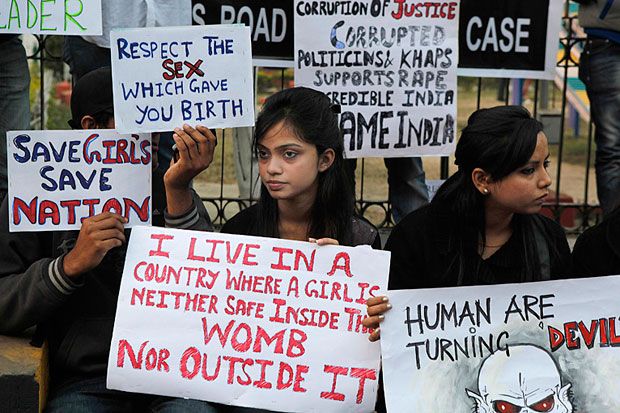
A survey3 by Trustlaw earlier this year of the G20 countries found, unsurprisingly that India, is the worst country to live in of the glorious top 20 if you happen to be incarnated in a female form, beating Saudi Arabia to the relegation spot. This damning statistic is compounded by an earlier study4 that placed India fourth (behind Afghanistan, Democratic Republic of Congo and Pakistan – all incidentally regarded as war zones) worst place on the planet to be a woman, it is The Guardian 15/6/115 report “ranked as extremely hazardous because of the subcontinent's high level of female infanticide and sex trafficking.” In 2009, Home Secretary at the time Madhukar Gupta estimated 100 million people, mostly women and girls were trafficked that year, nobody knows the true figure probably it was and remains higher.
Trafficking is mostly internal, with people living in greatest poverty, including children, the most vulnerable. Forced labour is the destination of most; the United Nations High Commission for Refugees (UNHCR)6 records “men, women, and children in debt bondage are forced to work in industries such as brick kilns, rice mills, agriculture, and embroidery factories. A common characteristic of bonded labor is the use of physical and sexual violence as coercive tools.” 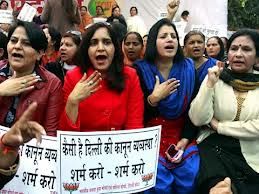 They go on to state that “concerns remain over the uneven enforcement of trafficking laws and alleged official complicity” – diplomatic speak for corruption. The Indian Government UNHCR conclude, “does not fully comply with the minimum standards for the elimination of trafficking”, but as it effects those with little or no voice, from marginalised sections of society, the pressure to act in accordance with international law, not to mention their moral and constitutional duty, is ignored in the pursuit of hyper GDP figures and increasing international market share.
They go on to state that “concerns remain over the uneven enforcement of trafficking laws and alleged official complicity” – diplomatic speak for corruption. The Indian Government UNHCR conclude, “does not fully comply with the minimum standards for the elimination of trafficking”, but as it effects those with little or no voice, from marginalised sections of society, the pressure to act in accordance with international law, not to mention their moral and constitutional duty, is ignored in the pursuit of hyper GDP figures and increasing international market share.
Domestic slavery together with prostitution and trafficking form an interrelated trinity of terror, orchestrated by criminal gangs, community members and patriarchal families that prey on the vulnerable and needy. Completing the picture of contemporary life for girls and women is arranged or forced marriages, plus extreme, frankly, unbelievable levels of female foeticide, which the United Nations (UN) population fund7 says amount to “Up to 50 million girls….’missing’ over the past century” due to such immoral practices.
Public shame
Into this polluted river of sexual abuse and violent intimidation comes the headline tragedy of an unnamed 23 year old paramedic student, who was raped by five men and a minor on a private bus in New Delhi, she later died from her injuries. The murderous attack is Human Rights Watch (HRW)8 29/12/12 state “a sobering reminder of the pervasive sexual violence that women and girls across India suffer,” and has brought students and young women onto the streets of Delhi, demanding justice. Some fuelled by anger and desire for retribution call for the death penalty for rape.
This appalling incident perpetrated against a woman from India’s new and growing middle class, has arrested media attention and caused public outrage. It is however, but the loudest cry of many such recent violations against women and represents a deep-seated sociological divide and injustice, reflective of distorted ideas of gender and control that allow Indian men to perpetrate all manner of abuse against women and to remain largely unpunished. Federal law is weak and painfully slow; police corrupt, poorly trained and uneducated. On 27th December HRW report, a young girl in the Punjab committed suicide because police did not register her complaint of gang rape a month earlier.
Under the mantle of the law
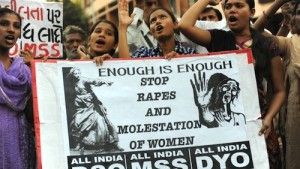
With most sexual assault cases being unreported and those registered being dismissed out of hand by police and family, or classed The Prajnya Trust in their report Gender Violence in India found9, “as one-off or trivial, as merely 'eve-teasing'," a perverse colloquialism for sexual harassment in public. It is virtually impossible to collate accurate figures, particularly when Adivasi women are the victims and police or security personnel are involved. HRW (29/12) relate one of myriad such cases, “in October 2011 police in Chattisgarh were accused of sexual assault of an Adivasi teacher, Soni Sori, while she was in their custody”, she had in fact gone to the police station looking for work and been detained by the superintendent who, with other officers repeatedly raped the woman.
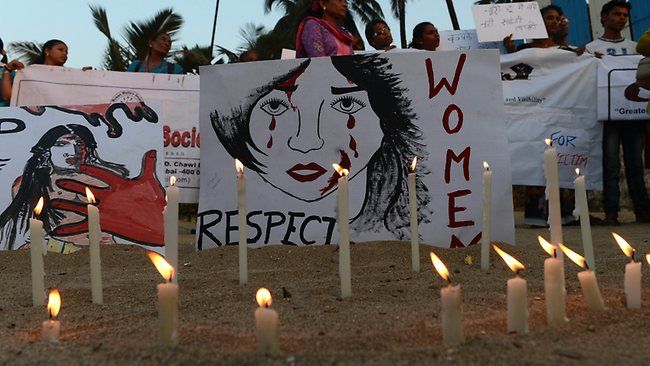
The police are effectively beyond the law, which makes it mandatory “for a prosecutor to obtain permission from the government to initiate criminal proceedings against public servants”(ibid). The security services, central reserve police force, military, Para-military, border security force are likewise immune, under ‘The Armed Forces Special Powers Act’, granting exemption to all those in uniform no matter their abusive actions and human rights violations, committed against the poor and most vulnerable, who they are duty bound to protect.
In addition to arrogant, dismissive police attitudes to reports of sexual abuse and potential parental restrictions on freedom of movement, the painfully slow judicial system and the legal framework for assault deter women from coming forward. There is no specific law or legal provision for the range of abuse suffered, simply a narrow definition, limited to ‘all forms of penetrative sexual assault, and covered under the spurious archaic definition of ‘outraging the modesty of a woman’, or the equally elusive, to ‘intrude on a woman’s privacy’, whatever that means. On the rare occasion charges are brought under such provision and a conviction won, the maximum penalty, the Hindustan Times (18/7/12)10 relay “is a [staggering} year's simple imprisonment, or a fine, or both”, rape carries a maximum seven years imprisonment. The laws clearly need fundamental reform; laws that currently allow sexual abuse to continue unpunished, offer immunity to those in uniform and help to sustain corrupt policing and the violent unjust treatment of women.
Gender inequality social injustice
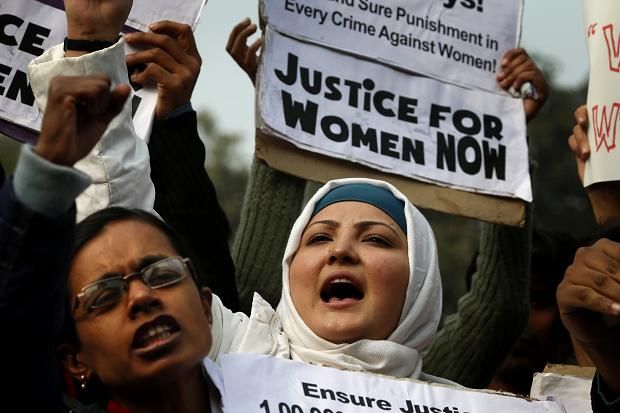
Even given the underreporting, registered rape the NCRB11 say, is increasing year on year, in 2011 they documented 24,206 reported cases, representing a fraction of the actual number. Add to this the daily sexual assaults of, molestation, intimidation and domestic violence at the hands of a husband or other family member, violent abuse that incidentally over half teenage girls believe is justified12, such is the distorted nature of gender relations that pervade and condition the Indian psyche, both male and female. As the father of the nation, Mahatma Gandhi said, “by sheer force of a vicious custom, even the most ignorant and worthless men have been enjoying a superiority over woman which they do not deserve and ought not to have.”13
Generation upon generation, have been conditioned to adopt a gender stereotype that reinforces male domination and female subservience, cloaking both in a shroud of suppression, causing untold suffering to women and maintaining a destructive unjust and poisonous social order. Patterns of behaviour justified under the much misappropriated banner of culture, allowing human rights violations and harmful social practices that need to be rooted out of India, to continue. Anuradha Gupta, of India's National Rural Health Mission14 explains, “When girls are brought up with the message that a woman's status in a family is inferior, she starts to accept whatever behaviour is meted out by her husband or in-laws." She added, "When a boy grows up seeing his father assault his mother, he starts to accept such a behavior and repeats it." Conditioned through ignorance into violence and servitude, impoverishing both the abuser and the abused, for “the suffering of the many is the illness of the whole.”15
Throughout India the International Research Centre for Women16 found, “social norms and practices are mostly governed by patriarchal ideologies,” attitudes that are incompatible with any recognizable definition of a just and democratic society, large or small. Issues of equality and the observation of basic human rights being the very foundations of democracy, and as Gandhi stated,
| “ |
of all the evils for which man has made himself responsible, none is so degrading, so shocking or so brutal as his abuse of the better half of humanity to me, the female sex, not the weaker sex. It is the nobler of the two, for it is even today the embodiment of sacrifice, silent suffering, humility, faith and knowledge. |
” |
In the race for commercial success and material wealth, intrinsic democratic values of fairness and justice, like the Adivasi people are being cast aside. The rupee rich blind and indifferent to the suffering of the nations girls and women, who cry out in pain and are heard not.
The widespread assault on the rights and dignity of women in India is a national plague, rooted in attitudes of gender inequality, suppression and control, injustices demanding the urgent attention of the Indian government and civil society. UN women17 20/12/12 express the right minded view, that “we need to take tougher action together to change the present reality and culture of impunity,” they stress, “the urgent need to promote and protect the safety of women and girls in India. Every girl and woman should be able to live safely and free of violence,” intimidation and fear. Such fundamental societal change will not be realized by initiating the equally barbaric death penalty for rape, or by much needed legislation alone. Destructive gender attitudes need to change, a widespread awareness and education programme to cleanse the current, narrow divisive ideas held by men throughout India is essential if women are to be treated with the respect and dignity that is their right.
1 http://www.ipsnews.net/2011/
2 http://www.youtube.com/watch?
3 http://www.trust.org/trustlaw/
4 http://www.trust.org/trustlaw/
5 http://www.guardian.co.uk/
6http://www.unhcr.org/cgibin/
7 www.unfpa.org/gender/docs/
8 http://www.hrw.org/news/2012/
9 http://www.prajnya.in/
10 http://www.hindustantimes.com/
11 http://articles.timesofindia.
12http://articles.
13 http://www.mkgandhi.org/
14 http://www.mkgandhi.org/
15 http://www.share-
16 http://www.icrw.org/media/
17 http://www.unwomensouthasia.
Graham Peebles
London
January 20
The Create Trust
Unity in Diversity
Graham Peebles is Director of the Create Trust, a UK registered charity supporting fundamental social change and the human rights of individuals in acute need.
_________________________________________
Articles for January 8, 2013 | Articles for January 9, 2013 | Articles for January 10, 2013 |    Support Salem-News.com:   | |||
Contact: adsales@salem-news.com | Copyright © 2025 Salem-News.com | news tips & press releases: newsroom@salem-news.com.
Terms of Service | Privacy Policy | ||||



All comments and messages are approved by people and self promotional links or unacceptable comments are denied.
[Return to Top]
©2025 Salem-News.com. All opinions expressed in this article are those of the author and do not necessarily reflect those of Salem-News.com.